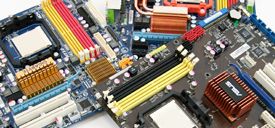Editor's Corner: 790GX On The Web

With the all-night benchmarking sessions and ensuing story on AMD’s new 790GX chipset out of the way, I sat down this morning to read what others on the Web had to say about the platform.

The company’s latest performs well, no doubt about it. The integrated graphics is most definitely faster than 780G and the inclusion of SB750 is a real life-saver on motherboards slated to cost somewhere around $150. Without ACC, it’d be incredibly difficult to justify the extra cost tacked onto 790GX boards versus 780G—and it might just be worth it to hold off until 790FX boards with SB750 are priced out.
Geoff over at TechReport came to a similar conclusion on pricing in his story, adding a tidbit on AHCI support on the SB750 southbrdge that I wasn’t able to test. Apparently the new I/O controller forces enthusiasts to jump through the same hoops to get AHCI support as its predecessor—something we’d hope would be changed by now, but apparently hasn’t been. I did have the opportunity to try adding a RAID array to an existing single-drive configuration. And while it was no problem to incorporate a pair of 500 GB drives, set them up for RAID 0 operation, and keep my boot drive separate, the simple act of switching to RAID mode meant the already-configured drive with Vista on it wouldn’t boot.
In his conclusion, Marco over at HotHardware had less of an issue with 790GX’s price tag and instead focused on an important point that seems to really be propping up AMD’s processor line up right now: the idea of a platform. Intel used to own this concept, selling its processors, chipsets, motherboards, networking controllers, RAID cards (the list goes on and on) in a package that was assumed to work better together because it all came from the same company. Just look at Centrino. Same sort of idea adapted for the mobile space. I remember when AMD launched the 760 chipset—the first Athlon platform with DDR support. It was determined to get out of core logic as soon as its partners had jumped on board the DDR train. Now the company can’t get enough of platforms, and we’ve seen several good ones as a result. Truly, though, 790GX is the first chipset to tie the platform and processor together with ACC. Previously, CrossFireX was the best reason to match AMD CPUs and AMD chipsets (and that was dubious at best since Intel supports CrossFire as well on platforms boasting faster CPUs). Now it’s ACC. Hopefully we see more of that platform message.
Unrelated to the 790GX, but interesting nonetheless, AMDZone’s Chris Tom worked some Intel G45 numbers into his coverage of AMD’s newest chipset. While the platform’s integrated core is still the slowest out there, it looks to be significantly faster than anything Intel has ever offered before. In fact, a couple of Chris’ benchmarks show G45 edging past Nvidia’s 780a SLI. We were also hoping to include G45 scores, but had to cut the testing short when we ran out of time. We are working on a comparison between G45 and a lesser-known AMD platform, though.
Perhaps more pressing for folks planning on picking up 790GX right away was Gary Key’s preview on AnandTech. In it, Gary recounts a number of issues he experienced with the initial batch of 790GX boards, including CrossFire with 4800-series Radeons, HDMI resolution problems, and trouble between OverDrive and the Phenom X4 9950 BE (AMD’s 2.6 GHz, 140 W model). His observations may help explain why we weren’t able to get our hands on the MSI and Foxconn boards in time for the chipset debut (we’ve already spoken to Asus and our problem with its board is unrelated to the issues Gary describes).
Based on Gary’s detailed list of outstanding quirks, it might be a good idea to either 1) hold off on 790GX until the board vendors iron out its wrinkles (see the story for specifics on where exactly you can expect to see issues today) or 2) simply wait until the 790FX/SB750 platform of your choosing becomes available. After all, enthusiasts building more powerful platforms will probably want to forgo the integrated graphics anyway in favor of more discrete connectivity.
Stay on the Cutting Edge
Join the experts who read Tom's Hardware for the inside track on enthusiast PC tech news — and have for over 25 years. We'll send breaking news and in-depth reviews of CPUs, GPUs, AI, maker hardware and more straight to your inbox.
Our conclusion on the 790GX still stands. The integrated platform is impressive, offering better graphics performance (albeit from a piece of silicon that isn’t new), more overclocking headroom, and new storage functionality. We’re still on the fence regarding the target audience, since 790GX boards will cost much more than 780G and are missing the HybridPower-like functionality that’d make them a solid win for power users. Nevertheless, it’s interesting to see what others are saying and experiencing with similar hardware.
If you’ve seen any other 790GX stories with interesting scores, unique features, or unexpected twists, let me know in the comments section and I’ll add my impressions. And to all who contributed feedback on our own coverage, thanks for making your voice heard.
-
jeb1517 "...the simple act of switching to RAID mode meant the already-configured drive with Vista on it wouldn’t boot."Reply
I tried this on the 780G board. I had xp installed on my SATA drive but everything was in IDE mode and I wanted to switch to AHCI mode. When I changed the option in BIOS, it gave me another option to let SATA ports 4 and 5 remain in IDE mode while the other ports were switched to AHCI. I connected my drive to port 4 and windows booted. After loading up, the "Found new hardware" wizard started and it installed the AHCI drivers from the motherboard CD. I then shut the computer off, switched my drive to port 1 and Windows booted. HOWEVER, with AHCI enabled, the boot sequence would pause for about 10 seconds which became really annoying (XP loading bar would freeze) and I didn't feel like dealing with it so I went back to having everything as IDE. Maybe you'll have better luck. -
ivaroeines I think this chipset it perfect for DIY's with a limited budget that need or want a replacement of their older computer, for people with 3 to 4 year old computers or older. For these people you get a gpu that most likely is faster than what they have now, most of them wont have to replace enclosure or powersupply( some may need to for connectivity ). They get a fairly future proof mainboard that will support not yet released cpu's and graphicscard for further upgrades at a later date. A cpu/mainboard/ram/gpu upgrade at this price is hard to beat. There are of course downsides, SB600/SB7** ACHI issue, AMD cpu performance and the single IDE channel are possibly the worst. You can not play current games on this platform alone, but the people im talking about couldnt do that on their current system either, but the initial investment is very small compared to what you get.Reply -
theLaminator Replyamd cpu performance ???
ok yeah intels making faster dchips but compare teh price difernece for what you get when you buy it the intel's are all that "Wow" inducing 1200 bucks diference from amd's top processor (230 at New egg) to intels top model(1400 at new eggs) and the intel chip is only 20-25 % faster ? do the math for teh price diference the intel chip doesn't offer near the performance it should that price is like 6 times what amd's cost so where is the performance ?
What about the Q9300? It doesn't have an unlocked multiplier but its faster a 45nm processor and only costs 35 dollars more. My experience with 45nm tells me you're not gonna be able to OC that black edition to the same speeds you could the Q9300 -
Pei-chen theLaminatorWhat about the Q9300? It doesn't have an unlocked multiplier but its faster a 45nm processor and only costs 35 dollars more. My experience with 45nm tells me you're not gonna be able to OC that black edition to the same speeds you could the Q9300No joking. I was thinking about selling my E6400 + board and go AMD instead of getting a Q6600 but I just couldn't justify that move. Nothing from AMD could beat Q6600 at stock or overclocked and the Q6600 is cheaper than 9950BE.Reply -
sdliddo Just wondering how this IGP would work with a 1680 X 1050 monitor.Reply
Got a VERY limited cash right now but computer broke. Doubt I'll have cash until like December so I was thinking this might work for me.
Only playing WoW.
Any thoughts
-
gsacks Comparisson between the G45 a a lesser known AMD platform? WTF.Reply
Please, if you are going to do a comparison, look at the soon to be available intel ITX board with the G45 chipset compared to the Nvidia and AMD ITX boards from Jetway and J&W respectively. That is the review that lots of HTPC enthusiasts are looking forward to. -
elerick this would be perfectly fine for wow. A laptop with low end gpu can run it fine, this should be able to have decent settings turned up and play smoothly. Just dont expect the world out of onboard video.Reply -
cangelini sdliddoJust wondering how this IGP would work with a 1680 X 1050 monitor. Got a VERY limited cash right now but computer broke. Doubt I'll have cash until like December so I was thinking this might work for me. Only playing WoW. Any thoughtsReply
Even if it means WoW at a lower resolution, the 790GX should be perfectly fine for the job. You should see how many people played with 4-5 year old hardware in my old guild :-P -
sdliddo cangeliniEven if it means WoW at a lower resolution, the 790GX should be perfectly fine for the job. You should see how many people played with 4-5 year old hardware in my old guild :-PReply
Hahaha. Yeah. Given the fact i want the P4 replaced I'm thinking of putting this on my older CRT monitor which runs 1152 X 864 resolution. Gonna have to shelve my nice 1680 x 1050 monitor until i can earn enough to get another computer. Of course will running just an X2 4800 be okay with this? or should i go with phenoms? -
cangelini gsacksComparisson between the G45 a a lesser known AMD platform? WTF.Please, if you are going to do a comparison, look at the soon to be available intel ITX board with the G45 chipset compared to the Nvidia and AMD ITX boards from Jetway and J&W respectively. That is the review that lots of HTPC enthusiasts are looking forward to.Reply
Sacks,
I'll ask around about the ITX versions. For the time being, microATX platforms should still give you a good idea of what the Intel and AMD core logic can do from a performance and functionality standpoint, right?
Most Popular


